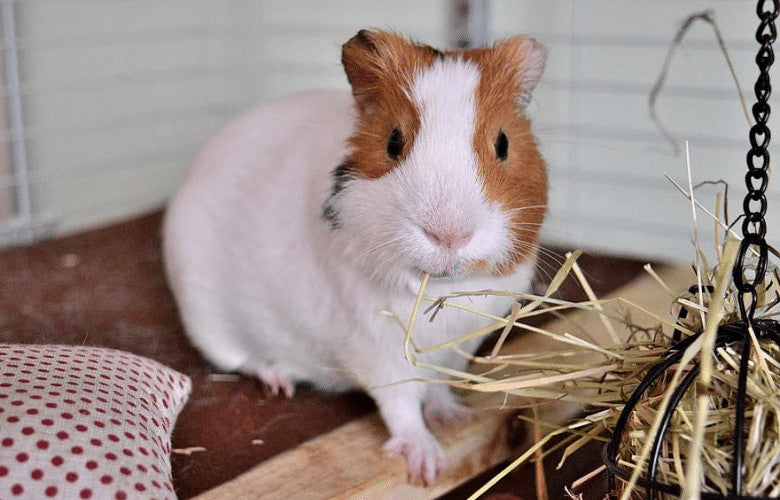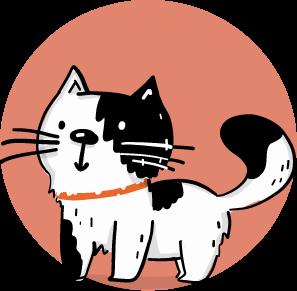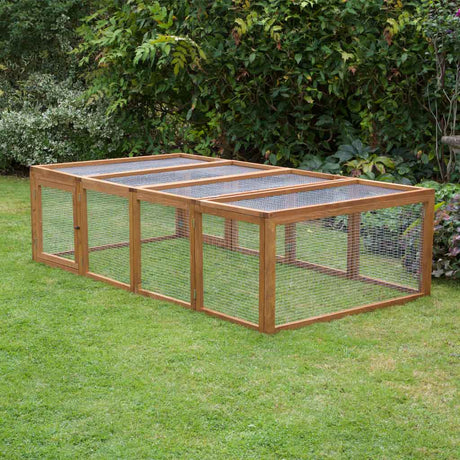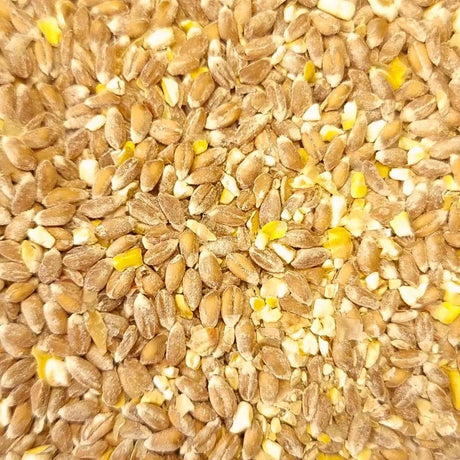But how much does a guinea pig poop in a day?
And is litter training really worth the effort? One healthy cavy can produce as much as 100 droppings a day. Should you have two or more cavies in a hutch, we're sure you'll agree that that is a lot of pig poop.

On the subject of poop, did you know your guinea pig's droppings can tell you a lot about their health?
The Advantages of Litter Training Your Piggies
There are definite benefits to training your guinea pigs to use a litter box. These include:
- A cleaner hutch - the most obvious one for us is a cleaner cage that doesn't smell.
- Less time cleaning - teaching your cavies to poop in a litter box makes cleaning the cage out much quicker.
- Saves money - training cavies to poop in a litter tray or in a designated area reduces the need to replace bedding all the time, and ends up saving money in the long run.
- Hygiene - wet and soiled bedding can result in your guinea pigs getting seriously ill. Providing them with litter trays where they can do their business can reduce the spread of germs around the hutch.
Spoiler alert! It might take some time to train your guinea pig to use the litter box. That's okay. Rather than getting frustrated with the process, you might want to manage your expectations.
Even if your piggies only use the litter tray every now and then, it's still reducing the amount of collateral damage lying around the hutch.
Two Types of Pooping Guinea Pigs
If you have had your cavies for a while, there is a good chance you would have noticed that each one is very different. Some like to wheek, while others popcorn about. And then there are those that mutter and chirp. Just as they all communicate in their own unique way, guinea pigs poop differently too.
Generally, there are two types of poopers:
Type 1:
Type 1 prefers to do their business in two or three spots around the hutch. When nature calls, these little guys will make their way to one of the favoured areas and do what they need to do.
Type 2:
Then there's type 2. This guinea pig thinks the world is its litter box and pretty much lets the poop fly wherever it is.
As you've probably gathered, Type 1 guinea pig will take to the litter box relatively quickly, but with patience and a little bit of persistence, there is no reason you won't be able to train Type 2.
10 Easy Ways To Litter Train Your Guinea Pig
Using our 10 steps to train your guinea pig to use a litter box will make the process a lot easier. Remember, however, we all have mishaps now and again, and the same applies to your cavy. Accidents are also more likely to happen in older piggies or ones that have health issues.
Keep potty training fun, and don't stress out if your piggies aren't 'getting' it. With enough practice, even if their toilet habits aren't perfect, you'll still see an improvement.
1. Start litter training by placing newspaper in their favourite toilet spots
In the same way, you would toilet train a puppy, you can start your guinea pig's potty training by placing newspaper in their favourite litter areas. Every few weeks remove a piece of the paper until you are down to one spot.
When you feel your guinea pigs are ready, you can swap the newspaper out for a litter box. To make the process even more straightforward, you could place some newspaper in the litter box for a few days.
2. Get the right sized litter box for your guinea pigs

Ideally, you want a litter box that is big enough for your guinea pig to move around in comfortably. Some of the boxes marketed for cavies may be too small, although you can find products that come in different sizes. Otherwise, look for rabbit litter trays.
Even cat litter trays will work. Just make sure to cut the side out for easy access. And sandpaper down any sharp bits to keep your guinea pigs safe.
Don't worry too much about the height of the box. You can teach your piggy to hop into the tray, or you can place hay all around the litter box, which will give your cavy a much-needed boost to get in.
Also remember to put hay in the box and make sure that it can't be tipped over easily. If your hutch isn't large enough, you can place newspaper in the corners as makeshift litter areas.
3. Use a different material to fill the litter tray
Guinea pigs are creatures of habit and can be taught where to do their business. A good idea is to use a different material in the potty tray compared to the rest of the hutch. We found newspaper works an absolute treat in the potty training area, while fleece works really well around the cage.
For more information on how to set up your guinea pig's cage with fleece, take a look here.
4. Make sure your guinea pigs have some privacy
Cavies are by nature very social creatures, but they do like some time to themselves to rest and rejuvenate, as well as go to the bathroom. If your guinea pigs have a favourite spot where they like to hide out, simply place a litter box inside the area, creating a little poo-bicle.
Be sure to place a few around the hutch and in their run. This way, they'll always have a safe place where they can do their business.
5. Teach your guinea pigs to jump into the litter tray
Did you know guinea pigs can be trained to jump? Not only is this a great way to keep them mentally stimulated and active, but it will also encourage them to jump in and out of their litter box.
This video clip shows you just how easy it is.
Keep in mind; however, older guinea pigs or those with health problems may not be able to do this, which means the litter box will need to be in an accessible area for them.
6. Place a hay rack close to their litter area

A clever way to keep your guinea pigs coming back to the litter box is by placing a hay rack nearby. It will also encourage them to stay a little longer. If it's not possible to attach a hay rack to the cage, you could always put some hay in the corner of the litter box.
7. Put accidental droppings into the litter box
Cavies are generally clean animals, and you can potty train them by placing droppings in the litter box every time they have an accident. Although it's a bit of a pain to do, it's a really effective way to get your guinea pigs toilet trained.
8. Place litter boxes around the hutch strategically
In the same way, you should put litter boxes in your cavies' favourite hide-out spots, it's also a good idea to strategically place a box or two near their favourite hang-out spots. Depending on the set up of your hutch, this could be close to their food bowls, or sleeping area.
9. Reward your guinea pigs with a treat when they use the litter box

The only thing piggies love more than pooping is a yummy treat. Make using the litter box a positive experience by rewarding them with a delicious snack whenever you see them using the box on their own.
If you need help with healthy treat ideas, this article is a must-read.
10. Remember to keep the litter box clean
If you want your guinea pig to use the toilet regularly, you must keep the area clean. The last thing you want is your pet avoiding the litter box because it's filled with poop. How often you clean them out will depend on how many piggies you have, as well as how many boxes there are. While we recommend once a day, you may need to do it two or three times a day.
Regularly grooming and cleaning your guinea pig is as important as keeping their hutch clean. This article will give you all the information you need for grooming guinea pigs.
Frequently Asked Questions About Litter Training Guinea Pigs
We're often asked about potty training guinea pigs, so we thought it a good idea to include a few of the most frequently asked questions.
How much do guinea pigs poop?
Guinea pigs poop a lot! If you're new to the world of cavies, just how much they poop might surprise you at first. One guinea pig can leave up to 100 droppings a day, so if you have three or more, you can expect to be cleaning poop out the hutch four or five times a day.
Can older guinea pigs be litter trained?
Older piggies can most definitely be potty trained, but keep in mind it might take a little longer. After all, old habits die hard. To teach your pet to use a litter box, we recommend using the same material in the box that you use in the hutch. It's also a good idea to use bedding that is slightly soiled as this will encourage your cavy to use it more often.
Are there litter boxes specially made for guinea pigs?
Yes, there are litter boxes that are specially made for guinea pigs. You can also use boxes that are suitable for rabbits. We always recommend choosing a litter box that is big enough for your piggies to move around in comfortably.
Is it necessary to keep litter boxes clean?
Most definitely. We've found in our experience the dirtier the box, the less guinea pigs are inclined to use it. How often you clean it out will depend on how many piggies you have, how often they use the litter area and how many litter areas you have around the hutch and run.
Need a quick recap? Why not take a look at this video?
Remember, never force your guinea pigs to use a litter box, and always keep it fun. Plenty of treats and positive reinforcement will go a long way in getting them to use their designated toilet area.
Hopefully, you found this article helpful and feel more confident with the process of potty training your guinea pigs. Maybe you have already successfully trained yours to use a litter box and can share a few tips with us in the comments below.









